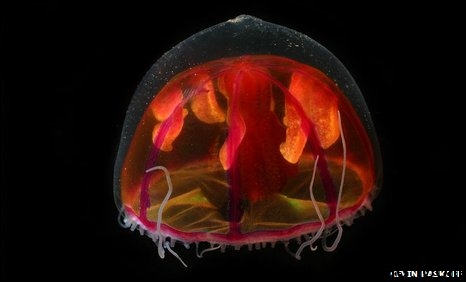| ||||||||||||||||||||||||||||||||||||||||||||||||||||||||||||||||||||||||||||||||||||||||
|
New details are emerging about the life-forms that survive in one of the world's most inaccessible1 places. 世界上最难以接近的地点之一存在的生命形式的更多细节正在慢慢浮现。  Crossota millsae, a brilliant red and purple jellyfish found at a depth of 2000m in the Arctic Ocean, is also found off California and Hawaii. Scientists have published descriptions of a range of jelly-like animals that inhabit the deep oceans of the Arctic. The animals were originally filmed and photographed during a series of submersible(能潜水的) dives in 2005. One of the biggest surprises is that one of the most common animals in the Arctic deep sea is a type of jellyfish(水母,海蜇) that is completely new to science. The deep Arctic ocean is isolated3 from much of the water elsewhere on the globe. One area, known as the Canadian Basin, is particularly cut off by deep-sea ridges4. These huge barriers can isolate2 any species there from other deep-water animals. So in 2005, an international team of scientists, funded primarily by the US National Oceanic and Atmospheric5 Administration's Office of Ocean Exploration and Research, conducted a series of deep-sea dives using a remote operated vehicle (ROV). Details of what they found have now been published in the journal Deep Sea Research Part II. "There were a lot of surprises," says biologist Dr Kevin Raskoff of Monterey Peninsula College in California, US, a leading member of the dive team. "One thing was just how many different jellies there were, and the sizes of their populations." "Some were somewhat well known from other oceans, but had not previously6 been found in the Arctic. That caused us to rethink our ideas about what the typical habitat would be for the species. We also discovered a number of new species that had not been found before." During a series of dives to depths of 3000m, the ROV filmed over 50 different types of gelatinous(胶粘的) or jelly-like animal. The majority of animals recorded were Medusae, a particular type of jellyfish that tend to be bell or disc shaped. Other jelly-like creatures seen included ctenophores, an unusual group that can look like jellyfish, but are not able to sting, siphonophores(管水母目动物), which are actually colonies of smaller animals living together in a structure that looks like a single, larger animal, and larvaceans, plankton-like creatures unrelated to jellyfish. Of all the Medusae observed, two species dominated at most locations visited by the ROV. The first was a species called Sminthea arctica, which lived at depths ranging from 100m to 2,100m. This jellyfish has been recorded before by scientific expeditions. However, the other common jelly was a species new to science. "Probably the single most interesting discovery was a new species of a small blue jellyfish, from a group called the Narcomedusae," says Dr Raskoff. "This group has several interesting features that set them apart from typical jellyfish, such as the fact that they hold their tentacles7(触须) over their bell as they swim." Most jellyfish let their tentacles drift in the water behind them, but the new species holds its tentacles out in front, perhaps enabling it to better catch prey8. The new species is so unusual that it has been classified within its own genus, and will be formally described later this year. "It was also the third most common jellyfish found on the cruise(巡航,巡弋), which is really surprising when you think about the fact that even the most common species in the area can be totally new and unexpected species," says Dr Raskoff. Another striking find was a type of ctenophore(栉水母) called Aulacoctena, which is one of the most spectacular examples of its kind. At over 15cm long, its tentacles can grip almost anything underwater, yet little is known about its lifestyle. However, one of the specimens9 collected by the ROV ejected its stomach contents, which revealed it may had fed on a bright orange animal. The researchers suspect it feeds on bright orange worms that also live in the Arctic deep, and it gets it colour from its prey. The scientists are now keen to find out much more about how these strange and enigmatic(谜的) creatures interact with their environment, and how they influence or underpin10 the ecology of the deep ocean in which they live. They also hope to raise funds to explore other little-visited regions of the deep Arctic ocean, as well as exploring the Aleutian trench11 off the coast of Alaska. "You don't have to go too far to find interesting areas to study, you just have to dive deep," says Dr Raskoff. 点击  收听单词发音 收听单词发音
|
||||||||||||||||||||||||||||||||||||||||||||||||||||||||||||||||||||||||||||||||||||||||
- 发表评论
-
- 最新评论 进入详细评论页>>



